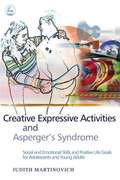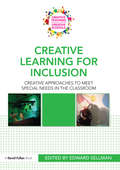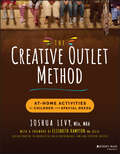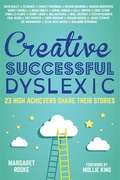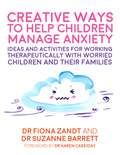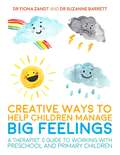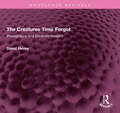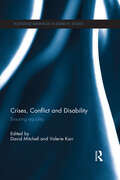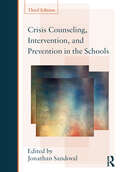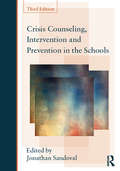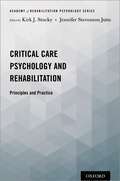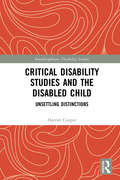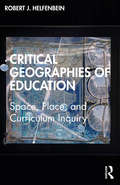- Table View
- List View
Creative Expressive Activities and Asperger's Syndrome: Social and Emotional Skills and Positive Life Goals for Adolescents and Young Adults
by Judith MartinovichIndividuals with Asperger's Syndrome (AS) benefit from a positive, affirming support of their individuality. This forward-looking book focuses on building individual strengths and resilience, rather than modifying perceived weaknesses, through individualized therapy within a group context. Integrating psychological and educational theory with a variety of creative therapies, Judith Martinovich combines activities such as art making, drama, music, puppetry, yoga and photography with conventional cognitive behavioral interventions to support individuals with AS. The different activities complement and reinforce each other and are designed to address specific traits of the autism spectrum to aid skills development. Although created primarily for use with adolescents and young adults, the practical and versatile activities can be adapted for different age and skill levels, objectives and settings. Informed by contemporary research, they meet the objectives of a framework of principles drawn from Positive Psychology and Social and Emotional Learning. Creative Expressive Activities and Asperger's Syndrome is a comprehensive resource for parents as well as teachers, social workers, psychologists and arts therapists who wish to link therapeutic goals with creative activities for people with or without Asperger's Syndrome.
Creative Expressive Activities and Asperger's Syndrome: Social and Emotional Skills and Positive Life Goals for Adolescents and Young Adults (PDF)
by Judith MartinovichIndividuals with Asperger's Syndrome (AS) benefit from a positive, affirming support of their individuality. This forward-looking book focuses on building individual strengths and resilience, rather than modifying perceived weaknesses, through individualized therapy within a group context. Integrating psychological and educational theory with a variety of creative therapies, Judith Martinovich combines activities such as art making, drama, music, puppetry, yoga and photography with conventional cognitive behavioral interventions to support individuals with AS. The different activities complement and reinforce each other and are designed to address specific traits of the autism spectrum to aid skills development. Although created primarily for use with adolescents and young adults, the practical and versatile activities can be adapted for different age and skill levels, objectives and settings. Informed by contemporary research, they meet the objectives of a framework of principles drawn from Positive Psychology and Social and Emotional Learning. Creative Expressive Activities and Asperger's Syndrome is a comprehensive resource for parents as well as teachers, social workers, psychologists and arts therapists who wish to link therapeutic goals with creative activities for people with or without Asperger's Syndrome.
Creative Learning for Inclusion: Creative approaches to meet special needs in the classroom (Creative Teaching/Creative Schools)
by Edward SellmanIntroducing creativity to the classroom is a concern for teachers, governments and future employers around the world, and there has been a drive to make experiences at school more exciting, relevant, challenging and dynamic for all young people, ensuring they leave education able to contribute to the global creative economy. Creative Learning to Meet Special Needs shows teachers how to use creativity in the curriculum for key stages 2 and 3 to support the learning of pupils with special educational needs in a way which effectively engages them and leaves a lasting impact on their school experiences and later lives. Describing the different ways in which a creative approach can help pupils with SEN access the curriculum, with activities and practical materials for teachers, this book will explain: why creativity is central to making the curriculum accessible how to use personalised learning with pupils with SEN how to promote achievements and motivation through creative experiences how the curriculum can be extended and represented in innovative ways for pupils with SEN how to use interactive methods of teaching and alternative methods of communication. Providing case studies and examples of the ways in which teachers have delivered the curriculum creatively to pupils with special educational needs, this book is an invaluable guide for all those involved in teaching and engaging young people with special needs.
Creative Learning for Inclusion: Creative approaches to meet special needs in the classroom (Creative Teaching/Creative Schools)
by Edward SellmanIntroducing creativity to the classroom is a concern for teachers, governments and future employers around the world, and there has been a drive to make experiences at school more exciting, relevant, challenging and dynamic for all young people, ensuring they leave education able to contribute to the global creative economy. Creative Learning to Meet Special Needs shows teachers how to use creativity in the curriculum for key stages 2 and 3 to support the learning of pupils with special educational needs in a way which effectively engages them and leaves a lasting impact on their school experiences and later lives. Describing the different ways in which a creative approach can help pupils with SEN access the curriculum, with activities and practical materials for teachers, this book will explain: why creativity is central to making the curriculum accessible how to use personalised learning with pupils with SEN how to promote achievements and motivation through creative experiences how the curriculum can be extended and represented in innovative ways for pupils with SEN how to use interactive methods of teaching and alternative methods of communication. Providing case studies and examples of the ways in which teachers have delivered the curriculum creatively to pupils with special educational needs, this book is an invaluable guide for all those involved in teaching and engaging young people with special needs.
The Creative Outlet Method: At-Home Activities for Children with Special Needs
by Joshua LevyA practical guide for parents and special educators to help enrich the lives of children with special needs In The Creative Outlet Method Book of Creativity: At-Home Activities for Children with Special Needs, certified special education educator Joshua Levy delivers practical and effective resources for conducting over 30 enriching theater arts and improvisational activities. The included exercises will allow children with disabilities to demonstrate creativity, increase self-confidence, and build social skills. Special needs children will benefit from the innovative approaches included in The Creative Outlet Method and experience creative energy from the comfort of home. The book also offers: Opportunities for children with special needs to achieve their academic, social, and behavioral goals Activities that enrich the lives of special needs students, their parents, and other caregivers A 10-step framework to improving the learning outcomes for children with special needs The Creative Outlet Method Book of Creativity is an indispensable resource for the parents and caregivers of special needs children, special education teachers, administrators, and therapists. It's also a must-read for K-12 general educators looking for ways to better engage with their special needs students.
The Creative Outlet Method: At-Home Activities for Children with Special Needs
by Joshua LevyA practical guide for parents and special educators to help enrich the lives of children with special needs In The Creative Outlet Method Book of Creativity: At-Home Activities for Children with Special Needs, certified special education educator Joshua Levy delivers practical and effective resources for conducting over 30 enriching theater arts and improvisational activities. The included exercises will allow children with disabilities to demonstrate creativity, increase self-confidence, and build social skills. Special needs children will benefit from the innovative approaches included in The Creative Outlet Method and experience creative energy from the comfort of home. The book also offers: Opportunities for children with special needs to achieve their academic, social, and behavioral goals Activities that enrich the lives of special needs students, their parents, and other caregivers A 10-step framework to improving the learning outcomes for children with special needs The Creative Outlet Method Book of Creativity is an indispensable resource for the parents and caregivers of special needs children, special education teachers, administrators, and therapists. It's also a must-read for K-12 general educators looking for ways to better engage with their special needs students.
Creative Sound Play for Young Learners: A Teacher’s Guide to Enhancing Transition Times, Classroom Communities, SEL, and Executive Function Skills
by Hayes GreenfieldThis fun and engaging guide invites you to use sound-making as a collaborative, play-based practice in your early childhood classroom—first to transform tricky transition times and ultimately to support your children’s executive functioning development and social-emotional learning. The book offers techniques and ideas for every teacher to reach every child in their classroom including verbal, nonverbal, and special needs children. Easy to integrate into all standard early years curricula, it focuses on three basic elements of sound: pitch, volume, and duration. The book features an "overview of the school year" calendar and an implementation guide, in addition to a variety of suggested sound-making activities that start out simply and, through the course of the book, expand to engage children’s creativity in more dynamic ways. Creative Sound Play for Young Learners is key reading for any preschool teacher, leader, or parent.
Creative Sound Play for Young Learners: A Teacher’s Guide to Enhancing Transition Times, Classroom Communities, SEL, and Executive Function Skills
by Hayes GreenfieldThis fun and engaging guide invites you to use sound-making as a collaborative, play-based practice in your early childhood classroom—first to transform tricky transition times and ultimately to support your children’s executive functioning development and social-emotional learning. The book offers techniques and ideas for every teacher to reach every child in their classroom including verbal, nonverbal, and special needs children. Easy to integrate into all standard early years curricula, it focuses on three basic elements of sound: pitch, volume, and duration. The book features an "overview of the school year" calendar and an implementation guide, in addition to a variety of suggested sound-making activities that start out simply and, through the course of the book, expand to engage children’s creativity in more dynamic ways. Creative Sound Play for Young Learners is key reading for any preschool teacher, leader, or parent.
Creative, Successful, Dyslexic: 23 High Achievers Share Their Stories
by Kelly Hoppen Mbe Zelda West-Meads Sir Richard Branson Sophie Conran Lynda La Cbe Margaret Rooke Theo Paphitis Zoe Wanamaker Cbe Sir Jackie Obe David Bailey Cbe Steven Naismith Paul Nixon Darcey Bussell Cbe Brian Conley Nigel Mccrery Ed Baines Meg Mathews Benjamin Zephaniah Mollie King Chris Robshaw Eddie Izzard Marcus Brigstocke Charley Boorman Kenny Logan Richard Rogers23 very well-known people from the arts, sport, and business worlds talk about how dyslexia affected their childhood, how they were able to overcome the challenges and use the special strengths of dyslexia to achieve great success in adulthood. Darcey Bussell CBE, Eddie Izzard, Sir Richard Branson, Meg Mathews, Zoe Wanamaker CBE, Richard Rogers, Benjamin Zephaniah, Steven Naismith, Lynda La Plante CBE, Sir Jackie Stewart OBE, Sophie Conran and others share their stories, and their advice. All reveal the enormous difficulties they faced, the strength required to overcome them, the crucial importance of adult support, and how `the different way the brain is wired' in dyslexia has enabled them to see something different in the world and to use their creativity in an exceptional way. They talk about `thinking sideways', and the ability to look at a bigger picture, the often strong visual strength, and the ability to listen, and to grasp simplicity where other people see only complexity. They also talk about how dyslexia continues to challenge them, and the ways they have found to work around this. An introduction, and final section that includes practical information about dyslexia, are written with the support of Dyslexia Action, and a percentage of profit from the book is donated to Dyslexia Action. The book will be essential reading for teachers and other professionals, and for families affected by dyslexia, and inspirational for people with dyslexia.
Creative, Successful, Dyslexic: 23 High Achievers Share Their Stories (PDF)
by Benjamin Zephaniah Brian Conley Charley Boorman Chris Robshaw Darcey Bussell Cbe David Bailey Cbe Ed Baines Eddie Izzard Kelly Hoppen Mbe Kenny Logan Lynda La Cbe Marcus Brigstocke Margaret Rooke Meg Mathews Mollie King Nigel Mccrery Paul Nixon Richard Rogers Sir Jackie Obe Sir Richard Branson Sophie Conran Steven Naismith Theo Paphitis Zelda West-Meads Zoe Wanamaker Cbe23 very well-known people from the arts, sport, and business worlds talk about how dyslexia affected their childhood, how they were able to overcome the challenges and use the special strengths of dyslexia to achieve great success in adulthood. Darcey Bussell CBE, Eddie Izzard, Sir Richard Branson, Meg Mathews, Zoe Wanamaker CBE, Richard Rogers, Benjamin Zephaniah, Steven Naismith, Lynda La Plante CBE, Sir Jackie Stewart OBE, Sophie Conran and others share their stories, and their advice. All reveal the enormous difficulties they faced, the strength required to overcome them, the crucial importance of adult support, and how `the different way the brain is wired' in dyslexia has enabled them to see something different in the world and to use their creativity in an exceptional way. They talk about `thinking sideways', and the ability to look at a bigger picture, the often strong visual strength, and the ability to listen, and to grasp simplicity where other people see only complexity. They also talk about how dyslexia continues to challenge them, and the ways they have found to work around this. An introduction, and final section that includes practical information about dyslexia, are written with the support of Dyslexia Action, and a percentage of profit from the book is donated to Dyslexia Action. The book will be essential reading for teachers and other professionals, and for families affected by dyslexia, and inspirational for people with dyslexia.
Creative Ways to Help Children Manage Anxiety: Ideas and Activities for Working Therapeutically with Worried Children and Their Families
by Fiona Zandt Suzanne BarrettThis book sets out therapeutic activities to help children aged 4-12 years and their families to better understand and manage anxiety. It explains how to work with anxious children, providing a framework for assessment and therapy that draws on CBT, ACT and narrative therapy approaches. Lots of practical tips for therapists are included and important developmental considerations are discussed, including adapting therapy for children with developmental difficulties, and working with families and schools.Over 50 playful therapeutic activities are included, which have been developed through the authors' extensive work with children, giving children an arsenal of coping strategies. They focus on key areas such as understanding anxiety, managing anxious thoughts, and building resilience and use readily available, inexpensive materials and downloadable templates which are provided in the book. This is the perfect tool for therapists looking for playful and purposeful ways to work with children with anxiety.
Creative Ways to Help Children Manage Anxiety: Ideas and Activities for Working Therapeutically with Worried Children and Their Families
by Fiona Zandt Suzanne BarrettThis book sets out therapeutic activities to help children aged 4-12 years and their families to better understand and manage anxiety. It explains how to work with anxious children, providing a framework for assessment and therapy that draws on CBT, ACT and narrative therapy approaches. Lots of practical tips for therapists are included and important developmental considerations are discussed, including adapting therapy for children with developmental difficulties, and working with families and schools.Over 50 playful therapeutic activities are included, which have been developed through the authors' extensive work with children, giving children an arsenal of coping strategies. They focus on key areas such as understanding anxiety, managing anxious thoughts, and building resilience and use readily available, inexpensive materials and downloadable templates which are provided in the book. This is the perfect tool for therapists looking for playful and purposeful ways to work with children with anxiety.
Creative Ways to Help Children Manage BIG Feelings: A Therapist's Guide to Working with Preschool and Primary Children (PDF)
by Dr Fiona Zandt Dr Lesley Bretherton Dr Suzanne BarrettTo be able to effectively offer therapy to children, complex therapeutic concepts need to be presented in an appropriate and engaging manner. This practical guide provides clinicians with a way in which to do so, with numerous games and imaginative activities to help children aged 4-12 to express and understand their feelings. Part I provides a comprehensive guide to working therapeutically with children and families, while Part II outlines 47 creative therapeutic activities. Each activity is presented with clear instructions using inexpensive and readily available resources and the objective and rationale of each activity is given, making it easily applicable. Activities range from using an easy to make volcano to help children better understand anger, to using a ball of string to illustrate how one person's feelings affect the whole family. This book is an invaluable resource for newly qualified clinicians, and also a treasure trove of creative ideas for experienced therapists.
The Creatures Time Forgot: Photography and Disability Imagery (Routledge Revivals)
by David HeveyFirst published in 1992, The Creatures Time Forgot examines the representation of disabled people – in advertising, particularly that produced by disability charities, and in the work of photographers such as Diane Arbus and Gary Winogrand. He shows how such images construct disabled people as ‘creatures,’ the tragic-but-brave objects of photographic gaze, or as the ‘’appy ‘andicapped’ of ‘positive imagery’ advertising. As a disabled photographer and writer, David Hevey has been a pioneer in challenging such visual representations of disabled people. His work advocates a move away from medical, charity or impairment-fixated imagery towards a visual equivalent of ‘Rights not Charity’. The book outlines David Hevey’s own photographic practice and includes wide-ranging selections from his work to create a visual form which reflects the new social presence of disabled people. This book will be of interest to students of media studies, cultural studies, and disability studies.
The Creatures Time Forgot: Photography and Disability Imagery (Routledge Revivals)
by David HeveyFirst published in 1992, The Creatures Time Forgot examines the representation of disabled people – in advertising, particularly that produced by disability charities, and in the work of photographers such as Diane Arbus and Gary Winogrand. He shows how such images construct disabled people as ‘creatures,’ the tragic-but-brave objects of photographic gaze, or as the ‘’appy ‘andicapped’ of ‘positive imagery’ advertising. As a disabled photographer and writer, David Hevey has been a pioneer in challenging such visual representations of disabled people. His work advocates a move away from medical, charity or impairment-fixated imagery towards a visual equivalent of ‘Rights not Charity’. The book outlines David Hevey’s own photographic practice and includes wide-ranging selections from his work to create a visual form which reflects the new social presence of disabled people. This book will be of interest to students of media studies, cultural studies, and disability studies.
Crises, Conflict and Disability: Ensuring Equality (Routledge Advances in Disability Studies)
by Valerie Karr David MitchellPeople with disabilities are among the most adversely affected during conflict situations or when natural disasters strike. They experience higher mortality rates, have fewer available resources and less access to help, especially in refugee camps, as well as in post-disaster environments. Already subject to severe discrimination in many societies, people with disabilities are often overlooked during emergency evacuation, relief, recovery and rebuilding efforts. Countries party to the UN Convention on the Rights of Persons with Disabilities must take all necessary measures to ensure the protection and safety of people with disabilities during situations of armed conflict, humanitarian emergencies, and natural disasters. Such aid should be designed to support preparedness, response, recovery and rebuilding. This book includes perspectives from around the globe and explores the implications at the policy, programme, and personal level, discussing issues such as: How can national laws, policies, and regulations provide guidance, methods and strategies to integrate and coordinate inclusive emergency management? What should people with disabilities know in order to be prepared for emergency situations? What lessons have we learned from past experiences? What are the current shortfalls (physical and cultural) that put people with disabilities at risk during emergencies and what can be done to improve these situations (e.g. through new technologies and disaster planning)? How does disability affect people’s experiences as refugees and other displaced situations; what programmes and best practices are in place to protect and promote their rights during their period of displacement? How must disabled people with disabilities be factored in to the resettlement and rebuilding process; does an opportunity for ensuring universal access exist in the rebuilding process? What is the impact of disasters and conflicts on such special populations as disabled women, disabled children, and those with intellectual disabilities? Spotlighting a pressing issue that has long been neglected in emergency planning fields, this innovative book discusses how to meet the needs of people with disabilities in crises and conflict situations. It is an important reference for all those working in or researching disability and inclusion, and emergency and disaster management, both in developed and developing countries.
Crises, Conflict and Disability: Ensuring Equality (Routledge Advances in Disability Studies)
by David Mitchell Valerie KarrPeople with disabilities are among the most adversely affected during conflict situations or when natural disasters strike. They experience higher mortality rates, have fewer available resources and less access to help, especially in refugee camps, as well as in post-disaster environments. Already subject to severe discrimination in many societies, people with disabilities are often overlooked during emergency evacuation, relief, recovery and rebuilding efforts. Countries party to the UN Convention on the Rights of Persons with Disabilities must take all necessary measures to ensure the protection and safety of people with disabilities during situations of armed conflict, humanitarian emergencies, and natural disasters. Such aid should be designed to support preparedness, response, recovery and rebuilding. This book includes perspectives from around the globe and explores the implications at the policy, programme, and personal level, discussing issues such as: How can national laws, policies, and regulations provide guidance, methods and strategies to integrate and coordinate inclusive emergency management? What should people with disabilities know in order to be prepared for emergency situations? What lessons have we learned from past experiences? What are the current shortfalls (physical and cultural) that put people with disabilities at risk during emergencies and what can be done to improve these situations (e.g. through new technologies and disaster planning)? How does disability affect people’s experiences as refugees and other displaced situations; what programmes and best practices are in place to protect and promote their rights during their period of displacement? How must disabled people with disabilities be factored in to the resettlement and rebuilding process; does an opportunity for ensuring universal access exist in the rebuilding process? What is the impact of disasters and conflicts on such special populations as disabled women, disabled children, and those with intellectual disabilities? Spotlighting a pressing issue that has long been neglected in emergency planning fields, this innovative book discusses how to meet the needs of people with disabilities in crises and conflict situations. It is an important reference for all those working in or researching disability and inclusion, and emergency and disaster management, both in developed and developing countries.
Crisis Counseling, Intervention and Prevention in the Schools (Consultation, Supervision, and Professional Learning in School Psychology Series)
by Jonathan SandovalSince the first edition was published in 1988, the role of crisis intervention and prevention has become central to mental health professionals working in the schools. Disasters such as hurricane Katrina, terrorist attacks both in this country and around the world, and various school shootings have greatly increased school crisis research and policy development. This book is designed for an introductory graduate course taken by students in school psychology, school counseling, and school social work. Section I provides a crisis response overview, section II deals with crises for children and adolescents and section III covers crises that manifest in adolescence. Discussions of the 16 most prevalent types of crises are covered in sections II and III and include their characteristics, causes, interventions, and preventive programs. All chapters will be updated, six heavily revised or totally rewritten by new authors, and two new chapters (chapters 8 & 19) have been added.
Crisis Counseling, Intervention and Prevention in the Schools (Consultation, Supervision, and Professional Learning in School Psychology Series)
by Jonathan SandovalSince the first edition was published in 1988, the role of crisis intervention and prevention has become central to mental health professionals working in the schools. Disasters such as hurricane Katrina, terrorist attacks both in this country and around the world, and various school shootings have greatly increased school crisis research and policy development. This book is designed for an introductory graduate course taken by students in school psychology, school counseling, and school social work. Section I provides a crisis response overview, section II deals with crises for children and adolescents and section III covers crises that manifest in adolescence. Discussions of the 16 most prevalent types of crises are covered in sections II and III and include their characteristics, causes, interventions, and preventive programs. All chapters will be updated, six heavily revised or totally rewritten by new authors, and two new chapters (chapters 8 & 19) have been added.
Critical Care Psychology and Rehabilitation: Principles and Practice (Academy of Rehabilitation Psychology Series)
by Kirk J. Stucky Jennifer Stevenson JutteThe primary focus of critical care is doing everything necessary to save lives. With so many things to manage, it comes as no surprise that the complex, multi-layered issues faced by critical illness survivors cannot be managed by intensive care specialists alone. Critical Care Psychology and Rehabilitation provides insight into holistic care of survivors. Written by leading experts, the book builds upon current literature and illustrates the benefits of integrating psychological and rehabilitation techniques throughout the care continuum. Chapters include summaries of treatment techniques, developments in intensive care settings, support and training for staff, and opportunities for further research. Although all chapters are relevant to contemporary psychology practice, the book is written in a style that is accessible to a wide audience of physicians, nurses, and other health professionals. Critical Care Psychology and Rehabilitation offers tools to improve the quality of intensive and post intensive care, with positive outcomes for patients, families, and caregivers.
Critical Care Psychology and Rehabilitation: Principles and Practice (Academy of Rehabilitation Psychology Series)
by Kirk J. Stucky Jennifer Stevenson JutteThe primary focus of critical care is doing everything necessary to save lives. With so many things to manage, it comes as no surprise that the complex, multi-layered issues faced by critical illness survivors cannot be managed by intensive care specialists alone. Critical Care Psychology and Rehabilitation provides insight into holistic care of survivors. Written by leading experts, the book builds upon current literature and illustrates the benefits of integrating psychological and rehabilitation techniques throughout the care continuum. Chapters include summaries of treatment techniques, developments in intensive care settings, support and training for staff, and opportunities for further research. Although all chapters are relevant to contemporary psychology practice, the book is written in a style that is accessible to a wide audience of physicians, nurses, and other health professionals. Critical Care Psychology and Rehabilitation offers tools to improve the quality of intensive and post intensive care, with positive outcomes for patients, families, and caregivers.
Critical Disability Studies and the Disabled Child: Unsettling Distinctions (Interdisciplinary Disability Studies)
by Harriet CooperThis book examines the relationship between contemporary cultural representations of disabled children on the one hand, and disability as a personal experience of internalised oppression on the other. In focalising this debate through an exploration of the politically and emotionally charged figure of the disabled child, Harriet Cooper raises questions both about what it means to ‘speak for’ the other and about what resistance means when one is unknowingly invested in one’s own abjection. Drawing on both the author’s personal experience of growing up with a physical impairment and on a range of critical theories and cultural objects – from Frances Hodgson Burnett’s novel The Secret Garden to Judith Butler’s work on injurious speech – the book theorises the making of disabled and ‘rehabilitated’ subjectivities. With a conceptual framework informed by both psychoanalysis and critical disability studies, it investigates the ways in which cultural anxieties about disability come to be embodied and lived by the disabled child. Posing new questions for disability studies and for identity politics about the relationships between lived experiences, cultural representations and dominant discourses – and demonstrating a new approach to the concept of ‘internalised oppression’ – this book will be of interest to scholars and students of disability studies, medical humanities, sociology and psychosocial studies, as well as to those with an interest in identity politics more generally.
Critical Disability Studies and the Disabled Child: Unsettling Distinctions (Interdisciplinary Disability Studies)
by Harriet CooperThis book examines the relationship between contemporary cultural representations of disabled children on the one hand, and disability as a personal experience of internalised oppression on the other. In focalising this debate through an exploration of the politically and emotionally charged figure of the disabled child, Harriet Cooper raises questions both about what it means to ‘speak for’ the other and about what resistance means when one is unknowingly invested in one’s own abjection. Drawing on both the author’s personal experience of growing up with a physical impairment and on a range of critical theories and cultural objects – from Frances Hodgson Burnett’s novel The Secret Garden to Judith Butler’s work on injurious speech – the book theorises the making of disabled and ‘rehabilitated’ subjectivities. With a conceptual framework informed by both psychoanalysis and critical disability studies, it investigates the ways in which cultural anxieties about disability come to be embodied and lived by the disabled child. Posing new questions for disability studies and for identity politics about the relationships between lived experiences, cultural representations and dominant discourses – and demonstrating a new approach to the concept of ‘internalised oppression’ – this book will be of interest to scholars and students of disability studies, medical humanities, sociology and psychosocial studies, as well as to those with an interest in identity politics more generally.
Critical Geographies of Education: Space, Place, and Curriculum Inquiry
by Robert J. HelfenbeinWINNER 2023 Society of Professors of Education Outstanding Book AwardCritical Geographies of Education: Space, Place, and Curriculum Inquiry is an attempt to take space seriously in thinking about school, schooling, and the place of education in larger society. In recent years spatial terms have emerged and proliferated in academic circles, finding application in several disciplines extending beyond formal geography. Critical Geography, a reconceptualization of the field of geography rather than a new discipline itself, has been theoretically considered and practically applied in many other disciplines, mostly represented by what is collectively called social theory (i.e., anthropology, sociology, cultural studies, political science, and literature). The goal of this volume is to explore how the application of the ideas and practices of Critical Geography to educational theory in general and curriculum theorizing in specific might point to new trajectories for analysis and inquiry. This volume provides a grounding introduction to the field of Critical Geography, making connections to the significant implications it has for education, and by providing illustrations of its application to specific educational situations (i.e., schools, classrooms, and communities). Presented as an intellectual geography that traces how spatial analysis can be useful in curriculum theorizing, social foundations of education, and educational research, the book surveys a range of issues including social justice and racial equity in schools, educational reform, internationalization of the curriculum, and how schools are placed within the larger social fabric.
Critical Geographies of Education: Space, Place, and Curriculum Inquiry
by Robert J. HelfenbeinWINNER 2023 Society of Professors of Education Outstanding Book AwardCritical Geographies of Education: Space, Place, and Curriculum Inquiry is an attempt to take space seriously in thinking about school, schooling, and the place of education in larger society. In recent years spatial terms have emerged and proliferated in academic circles, finding application in several disciplines extending beyond formal geography. Critical Geography, a reconceptualization of the field of geography rather than a new discipline itself, has been theoretically considered and practically applied in many other disciplines, mostly represented by what is collectively called social theory (i.e., anthropology, sociology, cultural studies, political science, and literature). The goal of this volume is to explore how the application of the ideas and practices of Critical Geography to educational theory in general and curriculum theorizing in specific might point to new trajectories for analysis and inquiry. This volume provides a grounding introduction to the field of Critical Geography, making connections to the significant implications it has for education, and by providing illustrations of its application to specific educational situations (i.e., schools, classrooms, and communities). Presented as an intellectual geography that traces how spatial analysis can be useful in curriculum theorizing, social foundations of education, and educational research, the book surveys a range of issues including social justice and racial equity in schools, educational reform, internationalization of the curriculum, and how schools are placed within the larger social fabric.
